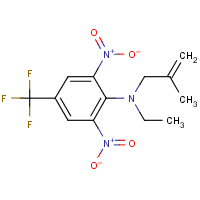Ethalfluralin
Agent Name
Ethalfluralin
CAS Number
55283-68-6
Formula
C13-H14-F3-N3-O4
Major Category
Pesticides

Synonyms
Buvilan; Compound 94961; EL 161; EL-161; Edge; Ethalfluraline [ISO-French]; N-Ethyl-N-(2-methyl-2-propenyl)-2,6-dinitro-4-(trifluoromethyl)benzenamine; N-Ethyl-N-(2-methylallyl)-2,6-dinitro-4-trifluoromethylaniline; N-Ethyl-alpha,alpha,alpha-trifluoro-N-(2-methylallyl)-2,6-dinitro-p-toluidine; Sonalan; Benzenamine, N-ethyl-N-(2-methyl-2-propen-1-yl)-2,6-dinitro-4-(trifluoromethyl)-; Benzenamine, N-ethyl-N-(2-methyl-2-propenyl)-2,6-dinitro-4-(trifluoromethyl)-; p-Toluidine, 2,6-dinitro-N-ethyl-N-(2-methyl-2-propenyl)-alpha,alpha,alpha-trifluoro-; [ChemIDplus]
Category
Herbicides, Nitroaromatic
Description
Yellow solid with a mild odor of amines; [HSDB] Yellow to orange solid; Emulsifiable concentrate (~33% active ingredient): yellowish orange liquid; [EFSA]
Sources/Uses
Used as selective pre-emergence herbicide for various grain, seed, and cucurbit crops; Primarily used on soybeans, dry beans, and sunflower seeds; [Reference #1]
Comments
Increased frequency of hepatocellular hyperplasia observed in 2-year feeding study of mice; Hemolytic anemia in 1-year feeding study of dogs; Developmental NOAEL much higher than maternal NOAEL in rats and rabbits; [HSDB] Irritating to skin and eyes of rabbits; May cause skin sensitization; Acute target organs are the liver, kidney, thyroid, and blood; Mutagenic effects with metabolic activation in vitro; “Limited evidence of a carcinogenic effect.” Mild reversible effects including lachrymation, burning sensation in the eyes, and headaches have been reported by workers in production facilities; [EFSA] A case of facial dermatitis following accidental direct exposure was reported in the California handler database; [Krieger, p. 770] In guinea pig skin sensitization studies, the modified Buehler method showed no sensitization, but the Magnusson and Kligman test was positive; Increased enzyme activity (SGPT and alkaline phosphatase) and increased liver weights observed in 3-month feeding study of mice; No systemic toxicity in dermal study of rabbits; Weakly or not mutagenic; Possible human carcinogen based on animal studies; [Reference #1]
Reference Link #1
Biomedical References
Exposure Assessment
Vapor Pressure
8.78E-05 mm Hg
Lethal Concentration
LC50 (rat) = 4980 mg/m3/4hr
Adverse Effects
Lachrymator
Yes
Hepatotoxin
Hepatoxic (a) from occupational exposure (secondary effect) or (b) in animal studies or in humans after ingestion
Diseases, Processes, and Activities Linked to This Agent
Processes
Industrial Processes with risk of exposure: